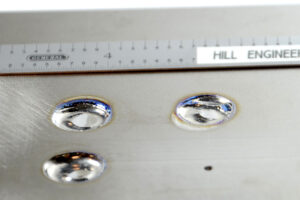Hill Engineering has recently acquired a new diffractometer and enclosure that will enable us to perform x-ray diffraction (XRD) residual stress measurements in our Rancho Cordova, California, laboratory.
X-ray diffraction is a useful technique for determining the distribution of residual stress near the surface of a specimen. This method uses the diffraction patterns created by x-rays interacting with the regular atomic lattice to quantify residual stress.
The x-ray penetration is relatively shallow in most materials, typically on the order of 0.001 inch (0.025 mm), allowing for the quantification of sharp residual stress gradients. Layer removal is used to measure residual stress at depths beyond the penetration distance.

The XRD system will allow us to measure different materials by easily replacing the x-ray tube used in the assembly. Additionally, it is possible for a wide range of specimen heights and measurement surface angles to be measured, enabling access to confined spaces and specimens with complex geometry.
We are excited to bring this equipment to our laboratory and further add to our suite of residual stress measurements we can offer to our customers.
For more information about our x-ray diffraction measurement capabilities or any of the residual stress measurement services we offer, please contact us.